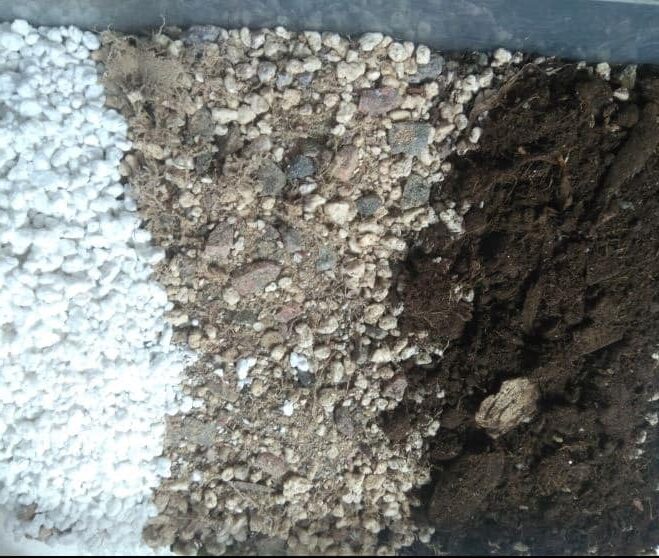Best soil for succulents
A suitable medium for succulents and cacti is a mix of a light potting soil or organic material. This part is pretty easy since anything well-drained that dries out quickly is fine.
A mix of the following will take you far:
- Coarse sand or small rocks
- Perlite
- Bark
- Pumice
Perlite is a great medium, since it absorbs excess moisture but also releases it back to the plant. However, it is extremely light and will fly off into the atmosphere when you sneeze. In some cases, perlite-dominated soil is so light that taller succulents may fall over since the soil cant fixate the roots, especially after repotting. Therefore, it’s good to mix stones and gravel in the soil. Perlite has also a tendency to float toward the top of the soil over time.
Vermiculite is often advised as a suitable medium for succulents and cacti. But when looking closer at what it actually does, it appears to have a reverse effects to a well drained soil – but more on this later.

How large part of each medium really depends on where you live and what you grow. I mostly aim for a fast-draining mix with lots of rocks and perlite, which seems to work fine for most succulents. Some succulents, like Living stones, are more extreme and prefer a mix of almost no organic material and seem very happy. This is surprising to a lot of people, including me. Since they have no access to any natural nutrients. Never argue with your plants, just listen to the clues they give you and act accordingly.
What is Perlite?
Perlite looks like a very light and white gravel that is mixed with organic soil. It very easy-to-handle, clean, and odorless material with a pH range of 6.6 to 7.5. Perlite originates from volcanic glass. It is produced with heat and transformed into small white balls, commonly known as perlite.
Perlite is Ideal for plants that thrive in well-drained soil, such as cacti or succulents. It allows excess water to drain and absorb quickly, as well as releasing water when the soil is dry. Despite being easily crushed into powder between fingers, this is rarely an issue as it doesn’t face that kind of pressure in pots or growing areas. Its primary role is improving soil aeration, lightening the soil, and providing better drainage and oxygen access to plant roots.
It is advised to be outdoors when dealing with perlite since it releases a lot of dust when handled. Also, since it is so light, the pot may be sensitive to falling in windy weather and may need good support, unless placed indoors. Sometimes perlite has tendency to float up to the surface in a pot over time, since it is so light and floats on water.
What is Vermiculite?
Vermiculite is derived from compressed dry flakes of an absorbent and spongy silicate material. It has a golden to dark red color, often blending seamlessly with the soil it’s mixed into. When water is added, vermiculite flakes expand, resembling a sponge soaking up water.
Vermiculite suits plants that thrive in consistently moist soil. It can absorb three to four times its volume when water is introduced, making containers a bit heavier. Unlike perlite, vermiculite acts as a sponge, absorbing more water but hindering soil aeration. This results in reduced oxygen availability for plant roots. Careful consideration of plant needs is crucial when deciding between perlite and vermiculite.
More Differences Between Vermiculite and Perlite
Significant differences exist between vermiculite and perlite, making the right choice essential to prevent garden mishaps. The primary divergence is that vermiculite blends with soil to retain water, while perlite enhances drainage.
Vermiculite protects seedlings from fungi that often harm seeds and aids water retention in tiny pots where seeds germinate. Perlite, while suitable for seedlings, excels when used in separate containers for enhanced drainage.
What to Use in Your Garden?
There’s an ongoing debate in the gardening community regarding the superior choice.
Use Perlite if…
- You have plants that need to dry out between waterings.
- You’re transplanting seedlings into separate pots.
- Your garden has clayey soil that needs loosening.
Adding perlite to clayey soil can eliminate both ridges and puddles, reduce temperature fluctuations, and enhance drainage and aeration. Different grades of horticultural perlite are available based on intended use, with fine to medium grades suitable for general applications. It’s weed-free, disease-free, and sterile.
Use Vermiculite if…
- You need an additive for plants requiring consistent moisture.
- You want robust seedlings in your seed trays.
